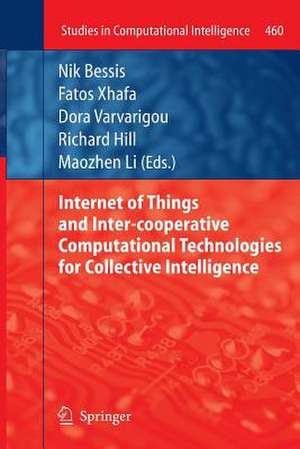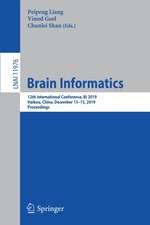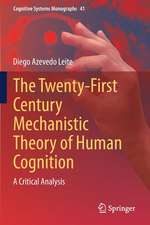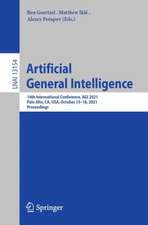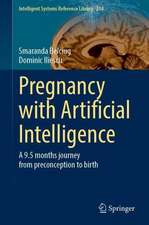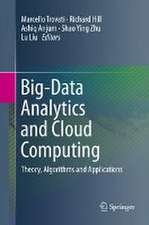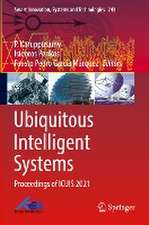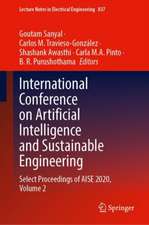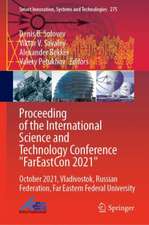Internet of Things and Inter-cooperative Computational Technologies for Collective Intelligence: Studies in Computational Intelligence, cartea 460
Editat de Nik Bessis, Fatos Xhafa, Dora Varvarigou, Richard Hill, Maozhen Lien Limba Engleză Paperback – 29 ian 2015
This trend has enabled the coupling of physical objects and digital information into cyber-physical systems and it is widely expected to revolutionize the way resource computational consumption and provision will occur. Specifically, one of the core ingredients of this vision, the so-called Internet of Things (IoT), demands the provision of networked services to support interaction between conventional IT systems with both physical and artificial objects. In this way, IoT is seen as a combination of several emerging technologies, which enables the transformation of everyday objects into smart objects. It is also perceived as a paradigm that connects real world with digital world.
The focus of this book is exactly on the novel collective and computational intelligence technologies that will be required to achieve this goal. While, one of the aims of this book is to discuss the progress made, it also prompts future directions on the utilization of inter-operable and cooperative next generation computational technologies, which supports the IoT approach, that being an advanced functioning towards an integrated collective intelligence approach for the benefit of various organizational settings.
| Toate formatele și edițiile | Preț | Express |
|---|---|---|
| Paperback (1) | 996.56 lei 6-8 săpt. | |
| Springer Berlin, Heidelberg – 29 ian 2015 | 996.56 lei 6-8 săpt. | |
| Hardback (1) | 1001.49 lei 6-8 săpt. | |
| Springer Berlin, Heidelberg – 14 dec 2012 | 1001.49 lei 6-8 săpt. |
Din seria Studies in Computational Intelligence
- 20%
 Preț: 449.37 lei
Preț: 449.37 lei - 20%
 Preț: 1158.26 lei
Preț: 1158.26 lei - 20%
 Preț: 986.66 lei
Preț: 986.66 lei - 20%
 Preț: 1452.76 lei
Preț: 1452.76 lei - 20%
 Preț: 168.78 lei
Preț: 168.78 lei - 18%
 Preț: 1112.30 lei
Preț: 1112.30 lei - 20%
 Preț: 565.38 lei
Preț: 565.38 lei - 20%
 Preț: 649.28 lei
Preț: 649.28 lei - 20%
 Preț: 1047.73 lei
Preț: 1047.73 lei - 20%
 Preț: 1578.96 lei
Preț: 1578.96 lei - 20%
 Preț: 643.50 lei
Preț: 643.50 lei - 20%
 Preț: 657.49 lei
Preț: 657.49 lei - 20%
 Preț: 993.28 lei
Preț: 993.28 lei - 20%
 Preț: 990.80 lei
Preț: 990.80 lei - 20%
 Preț: 989.96 lei
Preț: 989.96 lei - 20%
 Preț: 1165.69 lei
Preț: 1165.69 lei - 20%
 Preț: 1444.52 lei
Preț: 1444.52 lei - 20%
 Preț: 1041.96 lei
Preț: 1041.96 lei - 20%
 Preț: 1047.73 lei
Preț: 1047.73 lei - 20%
 Preț: 1046.06 lei
Preț: 1046.06 lei - 18%
 Preț: 2500.50 lei
Preț: 2500.50 lei - 20%
 Preț: 989.13 lei
Preț: 989.13 lei - 20%
 Preț: 1165.69 lei
Preț: 1165.69 lei - 20%
 Preț: 1164.05 lei
Preț: 1164.05 lei - 20%
 Preț: 1042.79 lei
Preț: 1042.79 lei - 20%
 Preț: 1460.19 lei
Preț: 1460.19 lei - 18%
 Preț: 1403.52 lei
Preț: 1403.52 lei - 18%
 Preț: 1124.92 lei
Preț: 1124.92 lei - 20%
 Preț: 1039.47 lei
Preț: 1039.47 lei - 20%
 Preț: 1008.11 lei
Preț: 1008.11 lei - 20%
 Preț: 1045.25 lei
Preț: 1045.25 lei - 20%
 Preț: 1275.42 lei
Preț: 1275.42 lei - 20%
 Preț: 1040.32 lei
Preț: 1040.32 lei - 20%
 Preț: 988.32 lei
Preț: 988.32 lei - 20%
 Preț: 1169.79 lei
Preț: 1169.79 lei - 20%
 Preț: 1162.37 lei
Preț: 1162.37 lei - 20%
 Preț: 1059.26 lei
Preț: 1059.26 lei - 20%
 Preț: 1164.05 lei
Preț: 1164.05 lei - 20%
 Preț: 1166.52 lei
Preț: 1166.52 lei - 20%
 Preț: 1459.38 lei
Preț: 1459.38 lei - 18%
 Preț: 1005.74 lei
Preț: 1005.74 lei - 20%
 Preț: 997.38 lei
Preț: 997.38 lei - 20%
 Preț: 1055.94 lei
Preț: 1055.94 lei - 20%
 Preț: 1284.47 lei
Preț: 1284.47 lei - 20%
 Preț: 994.08 lei
Preț: 994.08 lei - 20%
 Preț: 1048.72 lei
Preț: 1048.72 lei - 20%
 Preț: 1066.02 lei
Preț: 1066.02 lei - 20%
 Preț: 943.78 lei
Preț: 943.78 lei - 20%
 Preț: 1173.10 lei
Preț: 1173.10 lei - 20%
 Preț: 1457.72 lei
Preț: 1457.72 lei
Preț: 996.56 lei
Preț vechi: 1245.69 lei
-20% Nou
Puncte Express: 1495
Preț estimativ în valută:
190.69€ • 199.63$ • 157.78£
190.69€ • 199.63$ • 157.78£
Carte tipărită la comandă
Livrare economică 05-19 aprilie
Preluare comenzi: 021 569.72.76
Specificații
ISBN-13: 9783642444623
ISBN-10: 3642444628
Pagini: 476
Ilustrații: XVI, 476 p.
Dimensiuni: 155 x 235 x 25 mm
Greutate: 0.68 kg
Ediția:2013
Editura: Springer Berlin, Heidelberg
Colecția Springer
Seria Studies in Computational Intelligence
Locul publicării:Berlin, Heidelberg, Germany
ISBN-10: 3642444628
Pagini: 476
Ilustrații: XVI, 476 p.
Dimensiuni: 155 x 235 x 25 mm
Greutate: 0.68 kg
Ediția:2013
Editura: Springer Berlin, Heidelberg
Colecția Springer
Seria Studies in Computational Intelligence
Locul publicării:Berlin, Heidelberg, Germany
Public țintă
ResearchCuprins
State-of-the-art Critical Reviews.- Advanced Models and Architectures.- Advanced Applications and Future Trends.
Recenzii
From the reviews:
“The book does give definitions and examples of what the Internet of Things is now and what it might become. … if you are a PhD student in computing looking for very detailed information about how one might develop an Internet of Things application that might scale over the entire Web in a variety of scenarios, this book may be a valuable reference for you.” (Joan Horvath, Computing Reviews, May, 2013)
“The book does give definitions and examples of what the Internet of Things is now and what it might become. … if you are a PhD student in computing looking for very detailed information about how one might develop an Internet of Things application that might scale over the entire Web in a variety of scenarios, this book may be a valuable reference for you.” (Joan Horvath, Computing Reviews, May, 2013)
Textul de pe ultima copertă
Over the past two decades, we have witnessed unprecedented innovations in the development of miniaturized electromechanical devices and low-power wireless communication making practical the embedding of networked computational devices into a rapidly widening range of material entities.
This trend has enabled the coupling of physical objects and digital information into cyber-physical systems and it is widely expected to revolutionize the way resource computational consumption and provision will occur. Specifically, one of the core ingredients of this vision, the so-called Internet of Things (IoT), demands the provision of networked services to support interaction between conventional IT systems with both physical and artificial objects. In this way, IoT is seen as a combination of several emerging technologies, which enables the transformation of everyday objects into smart objects. It is also perceived as a paradigm that connects real world with digital world.
The focus of this book is on the novel collective and computational intelligence technologies that will be required to achieve this goal. While, one of the aims of this book is to discuss the progress made, it also prompts future directions on the utilization of inter-operable and cooperative next generation computational technologies, which supports the IoT approach, that being an advanced functioning towards an integrated collective intelligence approach for the benefit of various organizational settings.
This trend has enabled the coupling of physical objects and digital information into cyber-physical systems and it is widely expected to revolutionize the way resource computational consumption and provision will occur. Specifically, one of the core ingredients of this vision, the so-called Internet of Things (IoT), demands the provision of networked services to support interaction between conventional IT systems with both physical and artificial objects. In this way, IoT is seen as a combination of several emerging technologies, which enables the transformation of everyday objects into smart objects. It is also perceived as a paradigm that connects real world with digital world.
The focus of this book is on the novel collective and computational intelligence technologies that will be required to achieve this goal. While, one of the aims of this book is to discuss the progress made, it also prompts future directions on the utilization of inter-operable and cooperative next generation computational technologies, which supports the IoT approach, that being an advanced functioning towards an integrated collective intelligence approach for the benefit of various organizational settings.
Caracteristici
Discusses the theories, practices and concepts of utilising inter-operable and inter-cooperative next generation computational technologies Includes mobile and the emerging e-infrastructures of Web 2.0, SOA, P2P, Grids and Clouds Written by leading experts in the field
